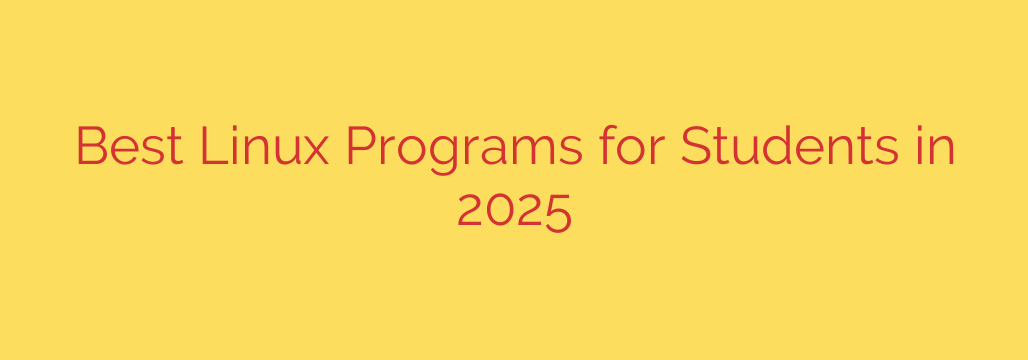
Top Linux Apps for Academic Success in 2025: A Student’s Guide
For students embracing the power and flexibility of the Linux operating system, finding the right software is key to academic excellence. Linux offers a robust ecosystem of free and open-source tools that can rival, and often surpass, their paid counterparts on other platforms. Whether you’re writing essays, coding a project, or analyzing complex data, this guide highlights the essential Linux programs every student should have installed in 2025.
The Ultimate Productivity Suite: LibreOffice
Every student needs a reliable office suite, and LibreOffice is the gold standard in the open-source world. This powerful collection of applications provides everything you need for day-to-day academic tasks.
- LibreOffice Writer: A full-featured word processor perfect for everything from short essays to your final thesis. It offers excellent compatibility with Microsoft Word formats (.docx), ensuring you can seamlessly share documents with classmates and professors.
- LibreOffice Calc: A versatile spreadsheet program that handles data analysis, charting, and complex formulas with ease. It’s an indispensable tool for business, science, and engineering courses.
- LibreOffice Impress: Create professional and compelling presentations for your classes. With a wide range of templates and effects, Impress is a powerful alternative to PowerPoint.
The entire LibreOffice suite is completely free, saving you the significant cost of a commercial software subscription while providing professional-grade tools.
Master Your Notes and Research
Staying organized is critical for academic success. These applications are designed to help you manage notes, sources, and complex information effortlessly.
- Joplin: An outstanding open-source note-taking and to-do application. What makes Joplin ideal for students is its powerful synchronization feature, allowing you to access your notes across your laptop, phone, and tablet. It supports Markdown formatting, web clipping, and end-to-end encryption for privacy.
- Zotero: This is a non-negotiable tool for any student writing research papers. Zotero is a free, easy-to-use reference manager that helps you collect, organize, cite, and share research. With browser extensions, it can grab source information from websites and academic databases with a single click. It then integrates with LibreOffice Writer to automatically generate bibliographies and in-text citations in any format you need (APA, MLA, Chicago, etc.).
Essential Tools for STEM and Programming Students
Linux has long been the preferred operating system for developers and scientists, and for good reason. The platform provides direct access to a wealth of powerful technical software.
- Visual Studio Code (VS Code): While developed by Microsoft, VS Code is an open-source code editor that has become the industry standard. It runs flawlessly on Linux and supports virtually every programming language imaginable through a vast library of extensions. Its integrated debugger, Git control, and smart completions make it the best all-in-one tool for computer science students.
- GNU Octave: If your coursework involves numerical analysis, linear algebra, or data visualization, you’ll likely encounter MATLAB. GNU Octave is a highly compatible, free alternative to MATLAB. It uses a very similar syntax, allowing you to complete assignments without purchasing an expensive software license.
- LaTeX (via Texmaker or Kile): For students in mathematics, physics, and computer science, LaTeX is the professional standard for typesetting documents. It produces beautifully formatted papers with complex mathematical equations that word processors simply can’t handle. Applications like Texmaker or Kile provide a user-friendly interface for writing and compiling LaTeX documents.
Unleash Your Creativity: Graphics and Design
Whether you’re in a design course or just need to create visuals for a presentation, Linux has you covered with professional-grade creative tools.
- GIMP (GNU Image Manipulation Program): This is the definitive open-source answer to Adobe Photoshop. GIMP is an incredibly powerful raster graphics editor for photo retouching, image composition, and digital painting. While it has a learning curve, it provides professional-level features at zero cost.
- Inkscape: For vector graphics—think logos, diagrams, and illustrations—Inkscape is the tool of choice. As a robust alternative to Adobe Illustrator, it’s perfect for creating scalable graphics for lab reports, posters, and web projects.
Actionable Security and System Tips for Students
A stable and secure system is crucial when deadlines are looming.
- Use System Snapshots with Timeshift: Before making major system changes or installing new drivers, use a tool like Timeshift. It creates a complete snapshot of your system. If an update goes wrong, you can restore your computer to a previous working state in minutes, saving you from a potential disaster during exam season.
- Enable Your Firewall: Most Linux distributions come with an Uncomplicated Firewall (UFW) pre-installed. It’s often disabled by default. A simple command in the terminal (
sudo ufw enable) can add a critical layer of security to your machine, especially when connected to public university Wi-Fi networks.
By equipping your Linux system with these powerful, free, and reliable applications, you can build a highly efficient and cost-effective academic workstation tailored for success.
Source: https://www.tecmint.com/linux-programs-for-students/








